sensor SUZUKI JIMNY 2021 Owner's Manual
[x] Cancel search | Manufacturer: SUZUKI, Model Year: 2021, Model line: JIMNY, Model: SUZUKI JIMNY 2021Pages: 421, PDF Size: 6.35 MB
Page 180 of 421

OPERATING YOUR VEHICLE
Automatic brake system When a frontal collision is unavoidable, the brakes will powerfully operate automatically. (#1)
Indicator Information display light
~ buzzer
78RB03033
(#1) After the vehicle has been stopped by the automatic brake system, the interior buzzer will continue to beep until the automatic brake system is released. Also, the indication on the information display and the dual sensor brake support indicator light will go off 3 seconds after the automatic brake system is released.
A CAUTION
After the vehicle has been stopped by the automatic brake system, immediately depress the brake pedal. If your vehicle is equipped with the automatic transmission, and when the automatic brake system is released, the vehicle will start to move by the creeping function. This may result in an accident.
NOTE: If you do not depress the clutch pedal when the vehicle has been stopped by the automatic brake system, the engine will stall.
3-29
Page 181 of 421
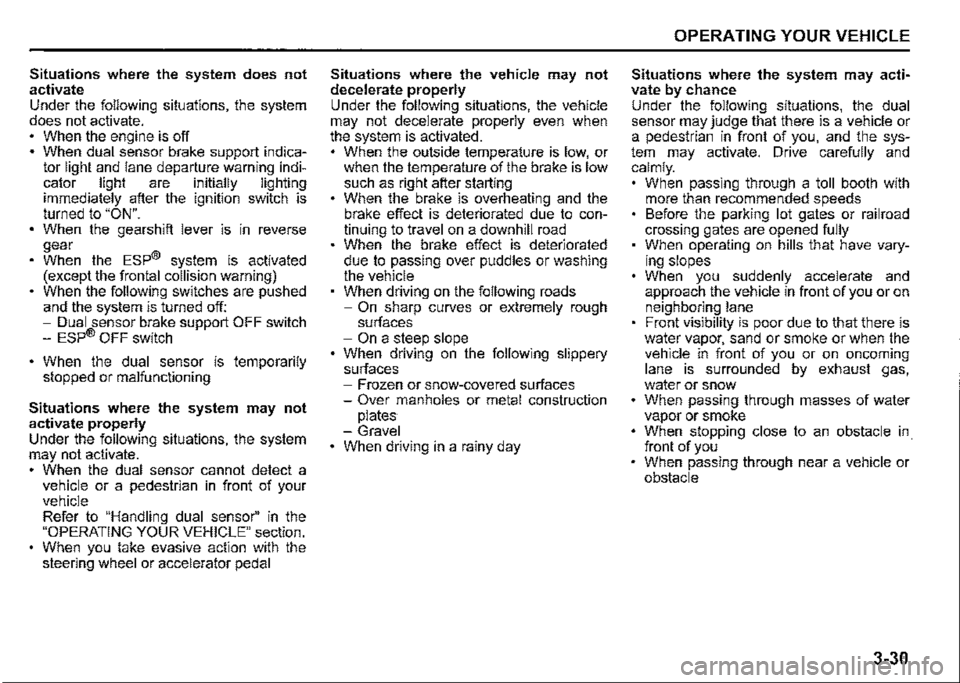
Situations where the system does not activate Under the following situations, the system does not activate. When the engine is off When dual sensor brake support indicator light and lane departure warning indicator light are initially lighting immediately after the ignition switch is turned to "ON". When the gearshift lever is in reverse gear When the ESP® system is activated (except the frontal collision warning) When the following switches are pushed and the system is turned off: -Dual sensor brake support OFF switch -ESP® OFF switch
When the dual sensor is temporarily stopped or malfunctioning
Situations where the system may not activate properly Under the following situations, the system may not activate. When the dual sensor cannot detect a vehicle or a pedestrian in front of your vehicle Refer to "Handling dual sensor" in the "OPERATING YOUR VEHICLE" section. When you take evasive action with the steering wheel or accelerator pedal
Situations where the vehicle may not decelerate properly Under the following situations, the vehicle may not decelerate properly even when the system is activated. When the outside temperature is low, or when the temperature of the brake is low such as right after starting When the brake is overheating and the brake effect is deteriorated due to continuing to travel on a downhill road When the brake effect is deteriorated due to passing over puddles or washing the vehicle When driving on the following roads -On sharp curves or extremely rough surfaces -On a steep slope When driving on the following slippery surfaces -Frozen or snow-covered surfaces -Over manholes or metal construction plates -Gravel When driving in a rainy day
OPERATING YOUR VEHICLE
Situations where the system may activate by chance Under the following situations, the dual sensor may judge that there is a vehicle or a pedestrian in front of you, and the system may activate. Drive carefully and calmly. When passing through a toll booth with more than recommended speeds Before the parking lot gates or railroad crossing gates are opened fully When operating on hills that have varying slopes When you suddenly accelerate and approach the vehicle in front of you or on neighboring lane Front visibility is poor due to that there is water vapor, sand or smoke or when the vehicle in front of you or on oncoming lane is surrounded by exhaust gas, water or snow When passing through masses of water vapor or smoke When stopping close to an obstacle in. front of you When passing through near a vehicle or obstacle
3-30
Page 182 of 421
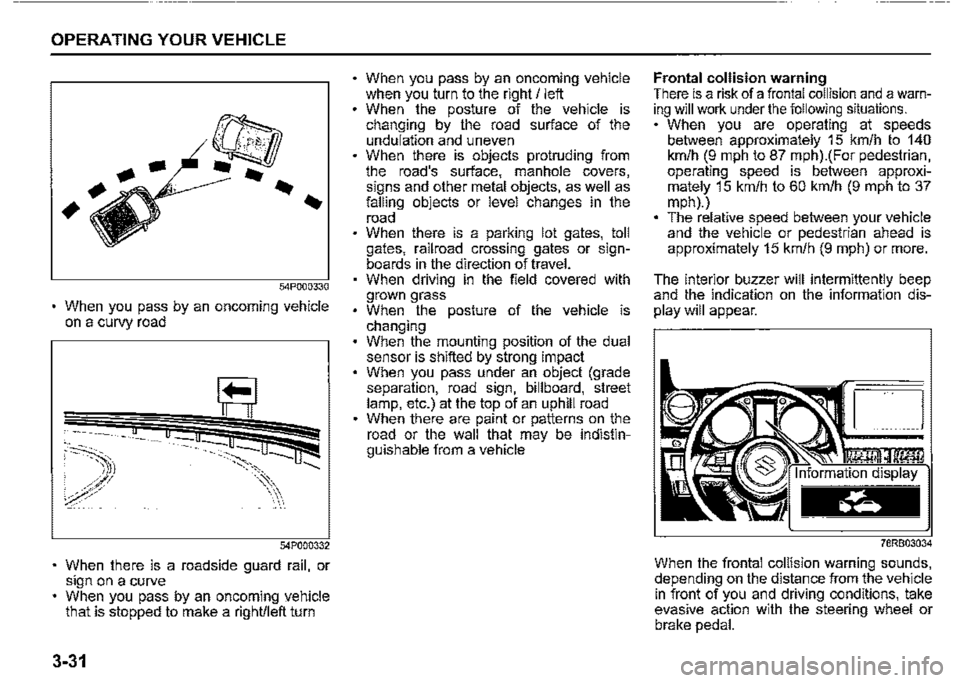
OPERATING YOUR VEHICLE
54P000330
When you pass by an oncoming vehicle on a curvy road
54?000332
When there is a roadside guard rail, or sign on a curve When you pass by an oncoming yehicle that is stopped to make a right/left turn
3-31
When you pass by an oncoming vehicle when you turn to the right/ left When the posture of the vehicle is changing by the road surface of the undulation and uneven When there is objects protruding from the road's surface, manhole covers, signs and other metal objects, as well as falling objects or level changes in the road When there is a parking lot gates, toll gates, railroad crossing gates or signboards in the direction of travel. When driving in the field covered with grown grass When the posture of the vehicle is changing When the mounting position of the dual sensor is shifted by strong impact When you pass under an object (grade separation, road sign, billboard, street lamp, etc.) at the top of an uphill road When there are paint or patterns on the road or the wall that may be indistinguishable from a vehicle
Frontal collision warning There is a risk of a frontal collision and a warning will work under the following situations. When you are operating at speeds between approximately 15 km/h to 140 km/h (9 mph to 87 mph).(For pedestrian, operating speed is between approximately 15 km/h to 60 km/h (9 mph to 37 mph).) The relative speed between your vehicle and the vehicle or pedestrian ahead is approximately 15 km/h (9 mph) or more.
The interior buzzer will intermittently beep and the indication on the information dis
play will appear.
78RB03034
When the frontal collision warning sounds, depending on the distance from the vehicle in front of you and driving conditions, take evasive action with the steering wheel or brake pedal.
Page 183 of 421

Brake assist system Under the followings and there is a high probability of a frontal collision, the brake assist system provides more powerful braking when you slam down on the brake pedal. When you are operating at speeds between approximately 15 km/h to 80 km/h (9 mph to 50 mph).(For pedestrian, operating speed is between approximately 15 km/h to 60 km/h (9 mph to 37 mph).) The relative speed between your vehicle and the vehicle or pedestrian ahead is approximately 15 km/h (9 mph) or more.
When the brake assist system activates, the frontal collision warning also activates at the same time.
Automatic brake system Under the followings and a frontal collision is judged to be unavoidable, the brakes will powerfully operate automatically. When you are operating at speeds between approximately 5 km/h to 100 km/h (3 mph to 62 mph).(For pedestrian, operating speed is between approximately 5 km/h to 60 km/h (3 mph to 37 mph).) The relative speed between your vehicle and the vehicle or pedestrian ahead is approximately 5 km/h (3 mph) or more.
When the automatic brake system is activated at a speed of approximately 50 km/h (31 mph) or under toward the vehicle in front of you (or toward the pedestrian, approximately 30 km/h (19 mph) or under), collisions may be avoidable.
While the automatic brake system is activating, the interior buzzer will continuously beep, the dual sensor brake support indicator light will blink rapidly, the indication on the information display will appear, and the brake lights will come on.
OPERATING YOUR VEHICLE
D
78RB03035
NOTE: The indication on the information display and the dual sensor brake support indicator light will go off after approximately 3 seconds after the automatic brake system is released.
3-32
Page 184 of 421
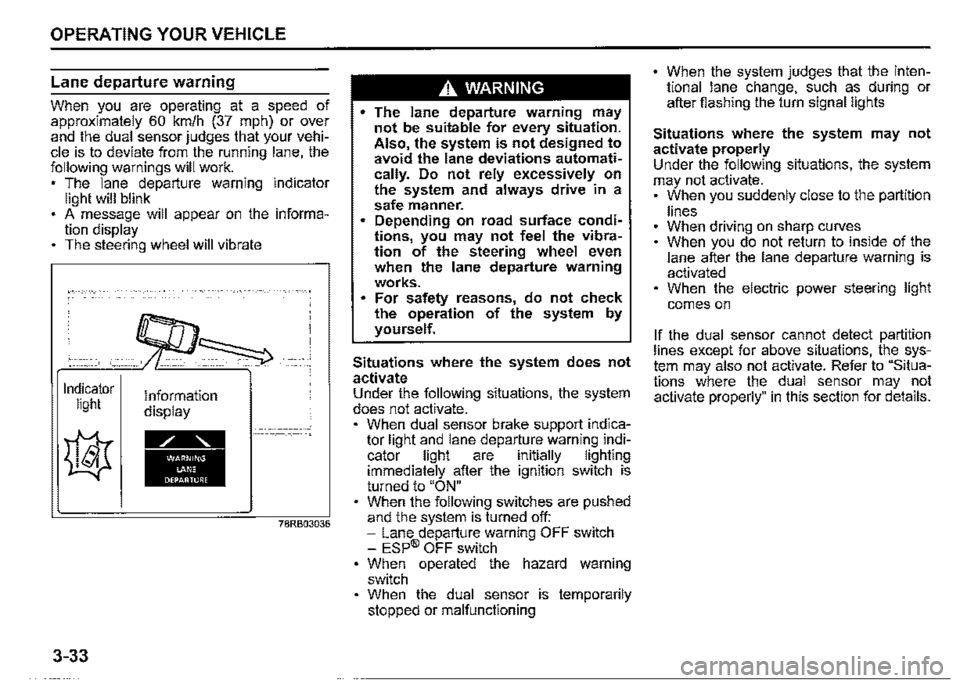
OPERATING YOUR VEHICLE
Lane departure warning
When you are operating at a speed of approximately 60 km/h (37 mph) or ov~r and the dual sensor judges that your vehicle is to deviate from the running lane, the following warnings will work. , The lane departure warning indicator light will blink . A message will appear on the information display The steering wheel will vibrate
Indicator light
3-33
Information display
78RB03036
A WARNING
• The lane departure warning may not be suitable for every situation. Also the system is not designed to avoid the lane deviations automati~ cally. Do not rely excessively on the system and always drive in a safe manner. Depending on road surface conditions, you may n~t feel the vibration of the steering wheel even when the lane departure warning works. For safety reasons, do not check the operation of the system by yourself.
Situations where the system does not activate Under the following situations, the system does not activate. , When dual sensor brake support indicator light and lane departu_re warni~g i~dicator light are 1nitially lighting immediately after the ignition switch is turned to "ON" When the following switches are pushed and the system is turned off: -Lane departure warning OFF switch -ESP® OFF switch When operated the hazard warning switch When the dual sensor is temporarily stopped or malfunctioning
When the system judges that the intentional lane change, such as during or after fiashing the turn signal lights
Situations where the system may not activate properly Under the following situations, the system may not activate. , When you suddenly close to the partition
lines When driving on sharp curves When you do not return to inside of th_e lane after the lane departure warning 1s activated When the electric power steering light
comes on
If the dual sensor cannot detect partition lines except for above situations, t~~ _system may also not activate. Refer to Situations where the dual sensor may not activate properly" in this section for details.
Page 185 of 421

Situations where the system may activate by chance Under the following situations, the system may activate. • When there are a lot of lines in the running lane When there is a shadow (for example, the shadow of the guardrail) parallel to the partition line When partition line is in the shadows When partition lines are drawn doubly When there is a liner paint on the road of a construction zone because the previous line has not been erased completely When there is repair marks on the road or a boundary between asphalt and snow When there is tyre marks on snow-covered or wet road When driving in the place without partition lines (such as a tailgate or checkpoint, or at an intersection, etc.) When driving on the road diverges, merges, etc. When driving on an unpaved or rough road
Vehicle swaying warning
When you are operating at a speed of approximately 60 km/h (37 mph) or over and the vehicle swaying warning judges that your vehicle is unsteadiness by detecting the meandering patterns or lane departure warning is activate_d in a s_hort period of time in a row following warnings will work. The lane departure warning indicator light will blink A message will appear on the information display The interior buzzer will intermittently beep
~CO)
A
Indicator Information light display
~
• 78RB03037
OPERATING YOUR VEHICLE
.A. WARNING
The vehicle swaying warning may not be suitable for every situation. Also, the system is not designed t? avoid the unsteadiness of the vehicle automatically. Do not rely excessively on the system and always drive in a safe manner. For safety reasons, do not check the operation of the system by yourself.
NOTE: Vehicle swaying warning by the meandering pattern of the vehicle in the lane is judged based on the driving data over the past several tens of minutes, so the system does not activate when right after swaying.
Situations where the system does not activate Under the following situations, the system does not activate. When dual sensor brake support indicator light and lane departure warning indicator light are initially lighting immediately after the ignition switch is turned to "ON". When the following switches are pushed and the system is turned off: -Lane departure warning OFF switch -ESP® OFF switch When the dual sensor is temporarily stopped or malfunctioning
3-34
Page 186 of 421
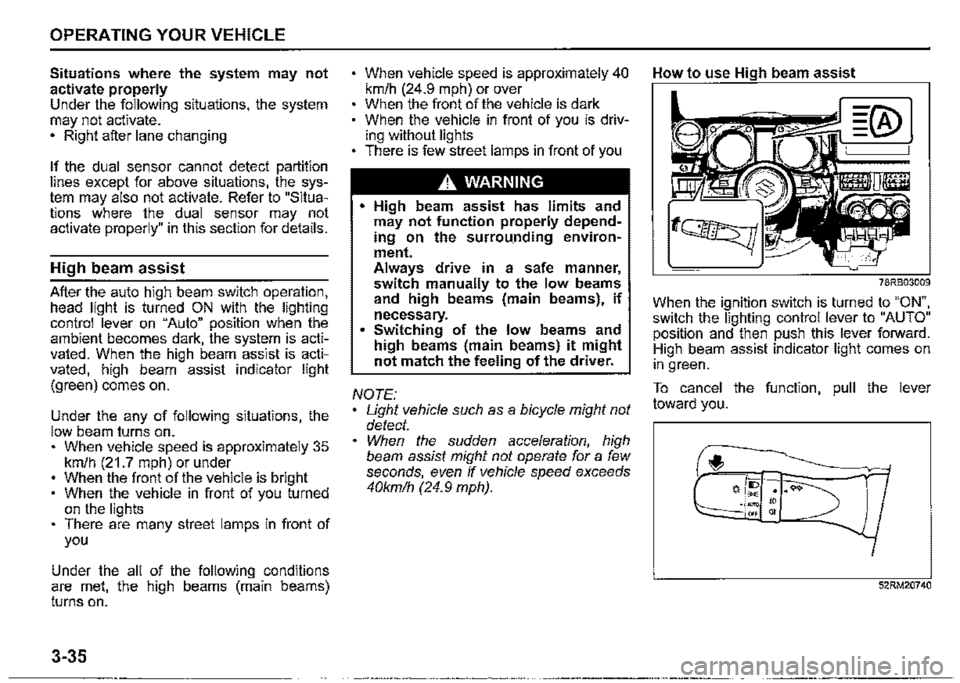
OPERATING YOUR VEHICLE
Situations where the system may not activate properly Under the following situations, the system may not activate. • Right after lane changing
If the dual sensor cannot detect partition lines except for above situations, the system may also not activate. Refer to "Situations where the dual sensor may not activate properly" in this section for details.
High beam assist
After the auto high beam switch operation, head light is turned ON with the lighting control lever on "Auto" position when the ambient becomes dark, the system is activated. When the high beam assist is activated, high beam assist indicator light (green) comes on.
Under the any of following situations, the low beam turns on. • When vehicle speed is approximately 35 km/h (21.7 mph) or under When the front of the vehicle is bright When the vehicle in front of you turned on the lights There are many street lamps in front of you
Under the all of the following conditions are met, the high beams (main beams) turns on.
3-35
When vehicle speed is approximately 40 km/h (24.9 mph) or over When the front of the vehicle is dark When the vehicle in front of you is driving without lights • There is few street lamps in front of you
A. WARNING
• High beam assist has limits and may not function properly depending on the surrou.nding environment. Always drive in a safe manner, switch manually to the low beams and high beams (main beams), if necessary. Switching of the low beams and high beams (main beams) it might not match the feeling of the driver.
NOTE: Light vehicle such as a bicycle might not detect. When the sudden acceleration, high beam assist might not operate for a few seconds, even if vehicle speed exceeds 40kmlh (24.9 mph).
How to use High beam assist
78RB03009
When the ignition switch is turned to "ON", switch the lighting control lever to "AUTO" position and then push this lever forward. High beam assist indicator light comes on in green.
To cancel the function, pull the lever toward you.
f,
52RM20740
Page 187 of 421
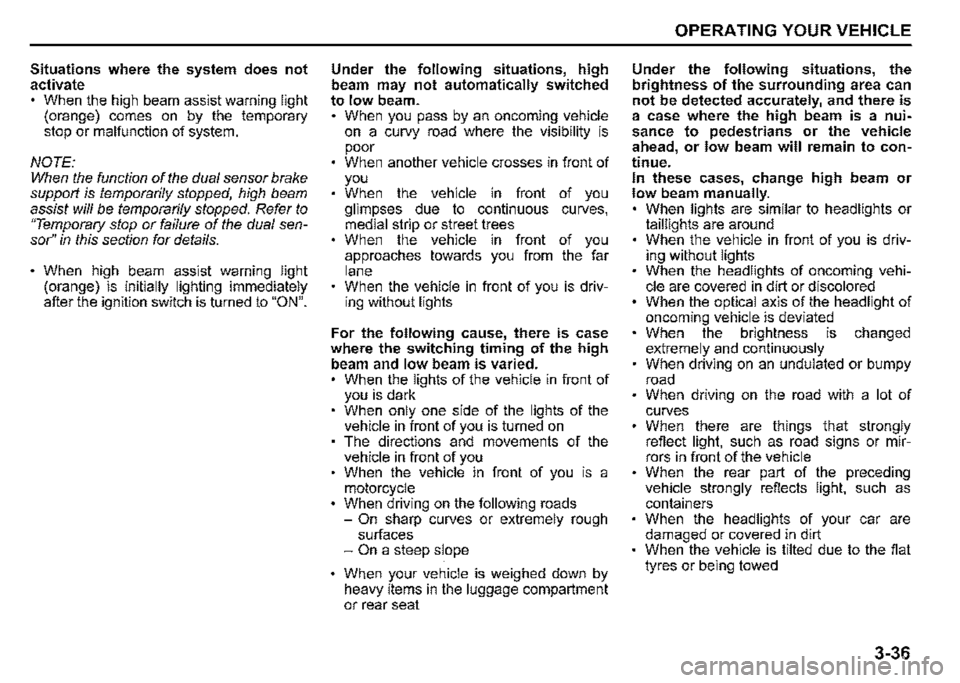
Situations where the system does not activate When the high beam assist warning light (orange) comes on by the temporary stop or malfunction of system.
NOTE: When the function of the dual sensor brake support is temporarily stopped, high beam assist will be temporarily stopped. Refer to "Temporary stop or failure of the dual sensor'' in this section for details.
When high beam assist warning light (orange) is initially lighting immediately after the ignition switch is turned to "ON".
Under the following situations, high beam may not automatically switched to low beam. When you pass by an oncoming vehicle on a curvy road where the visibility is poor When another vehicle crosses in front of you When the vehicle in front of you glimpses due to continuous curves, medial strip or street trees When the vehicle in front of you approaches towards you from the far lane When the vehicle in front of you is driving without lights
For the following cause, there is case where the switching timing of the high beam and low beam is varied. When the lights of the vehicle in front of you is dark When only one side of the lights of the vehicle in front of you is turned on The directions and movements of the vehicle in front of you When the vehicle in front of you is a motorcycle When driving on the following roads -On sharp curves or extremely rough surfaces -On a steep slope
When your vehicle is weighed down by heavy items in the luggage compartment or rear seat
OPERATING YOUR VEHICLE
Under the following situations, the brightness of the surrounding area can not be detected accurately, and there is a case where the high beam is a nuisance to pedestrians or the vehicle ahead, or low beam will remain to continue. In these cases, change high beam or low beam manually. When lights are similar to headlights or taillights are around When the vehicle in front of you is driving without lights When the headlights of oncoming vehicle are covered in dirt or discolored When the optical axis of the headlight of oncoming vehicle is deviated When the brightness is changed extremely and continuously When driving on an undulated or bumpy road When driving on the road with a lot of curves When there are things that strongly reflect light, such as road signs or mirrors in front of the vehicle When the rear part of the preceding vehicle strongly reflects light, such as containers When the headlights of your car are damaged or covered in dirt When the vehicle is tilted due to the flat tyres or being towed
3-36
Page 188 of 421

OPERATING YOUR VEHICLE
Other than the described above, the dual sensor cannot be detected the vehicle in front of you or light source, and there is a case where high beam assist may not activate properly. Refer to "Situations where the dual sensor may not activate properly" in this section for details.
Under the following situations, switch high beam or low beam manually, When switching back and forth between the high beams (main beams) and low beams frequently When there is a problem using the high beams (main beams) When it is considered disturbing to other drivers or pedestrians
There is a case where high beams (main beams) is switched to low beams by the fog lights of the vehicle in front of you.
Street lights, traffic signals, and illumination of billboards or signs may cause the high beams (main beams) to switch to the low beams, or low beam to remain on.
3-37
Dual sensor brake support OFF switch
You can turn off the dual sensor brake support system. In the following situations, push and hold the dual sensor brake support OFF switch as unexpected dangers may be possible if ii is activated. -When the vehicle is placed upon atester such as when undergoing a vehicle inspection -When the vehicle is put up on a lift, and the tyres are idling -When the vehicle is being towed -When the vehicle is being carried on a car carrier -When the vehicle is being operated on a race track -When there is vinyl curtains or pendulous branches in front of the vehicle -When driving in the field covered with grown grass -When using an automatic car washer -When the vehicle is placed upon a car elevator or placed in a mechanical parking lot -With a spare tyre or snow chains equipped -When you have a temporarily repaired flat tyre -When you have an accident or breakdown -When the automatic brake system is activated frequently
-When tyres are not inflated to the recommended tyre pressure -With worn tyres equipped -With non-specified sized tyres or wheels equipped -With a modified suspension equipped -When attaching an item which inter-feres with the visibility of the dual sensor -When the vehicle is being weighed down by heavy items -When the vehicle is used to tow a trailer
78RB03010
Page 189 of 421

When you want to turn off the system, push and hold the dual s_ensor_ brake support OFF switch (1) until the interior buzzer beeps and the dual sensor brake support OFF indicator light (2) comes on.
Perform the following method to turn the system back on. • Push and hold the dual sensor brake support OFF switch (1) until the interior buzzer beeps and the dual sensor brake support OFF indicator light (2) goes off. Turn off the engine and then turn it on again.
A WARNING
If you attempt to press the dual sensor brake support OFF switch while driving, you could lose control of the vehicle. Do not press the dual sensor brake support OFF switch while driving.
Lane departure warning OFF switch
You can turn off the lane departure warning and the vehicle swaying warning.
i~ (2) -
OFF
~i
□ ~ (1) ii _____ Jj
78RB03011
When you want to turn off the system, push and hold the lane departure warning OFF switch (1) until the interior buzzer beeps and the lane departure warning OFF indicator light (2) comes
on.
Perform the following method to turn the system back on. • Push and hold the lane departure warning OFF switch (1) until the interior buzzer beeps and the lane departure warning OFF indicator light (2) goes off.
OPERATING YOUR VEHICLE
A WARNING
If you attempt to press the lane departure warning OFF switch while driving, you could lose control of the vehicle. Do not press the lane departure warning OFF switch while driving.
·NOTE: Once the system is turned off, it does not turn on automatically, even if you turn off the engine and then starl the engine again. To turn the system back on, push the switch again.
3-38